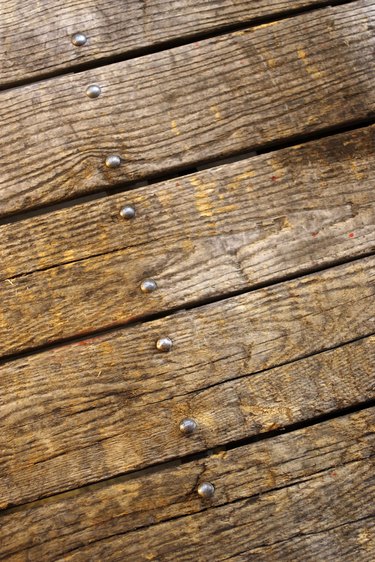 Creaks in your old floor don’t necessarily point to rot. Image Credit: Liquidlibrary/liquidlibrary/Getty Images
Creaks in your old floor don’t necessarily point to rot. Image Credit: Liquidlibrary/liquidlibrary/Getty Images
A certain amount of creaking almost is inevitable in old floors, and it can occur for more than one reason. It can be accompanied by lumps in the floor as fasteners holding the floorboards or subfloor work themselves loose. If there is rot involved with the creaks and lumps, it makes the repair more urgent, because rot spreads. Spotting telltale signs of rot and quickly getting it under control may save the floor.
Creaking That Isn’t Related to Rot
Plywood, particleboard and OSB subfloors can pop up at the corners when installers use an insufficient number of fasteners, especially if the fasteners are nails. The resultant lump is easily noticeable under carpet, and you may even feel it under a laminate floor. Similarly, hardwood boards can lift when held by insufficient fasteners or when the subfloor deteriorates, which is most common with particleboard. No rot is involved with either of these defects. A small amount of ambient moisture — not enough to rot wood — can be enough to swell wooden floorboards, which may start creaking as they rub together when you walk on them.
Moisture
The most telling indication that a squeaky and lumpy floor may be rotting is the presence of moisture. Moisture may not be apparent on the surface, especially if the floor covering is hardwood, but you may see indications of it from underneath. Signs include discolored joists and subfloor or, if there's a ceiling, spots in the drywall. You also may smell mold, especially if the floor is covered with carpet. If moisture is present, you're most likely to find it around lumps, which may be caused by wood springing off loose fasteners or by swelling of the subfloor.
Sagging and Sponginess
Creaking and lumps could simply be the result of loose fasteners, but sagging and sponginess more often are the result of moisture. The sagging may be visually apparent, or you may have to walk on the affected area to notice it. Rotted subfloors eventually turn spongy, and when you walk on a rotted area, the lack of support offered by the floor becomes increasingly noticeable. The sagging and sponginess may be right next to a lump in the floor, because moisture and rot can warp the subfloor, causing part of it to sag and part to lift off the joists.
Repair Strategy
If you suspect rot in the subfloor, it's important to prevent it from spreading. The first course of action after addressing the cause of the moisture is to uncover the affected area to allow it to dry out. This usually involves removal of the floor covering from the affected area. The next step is to replace all the rotten wood. Taken together, these are two repairs often extensive enough to warrant replacing the floor covering altogether. If no rot is present, you usually can stop creaking with well-placed shims, screws or subfloor anchors. Spreading talc on the floor stops creaking caused by swollen floorboards.


